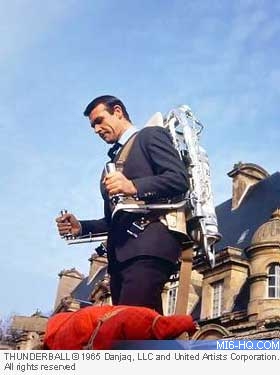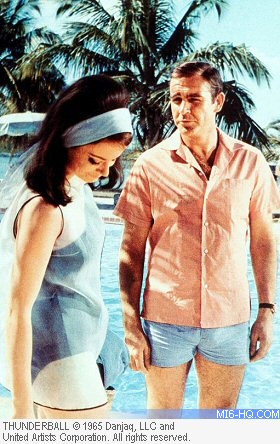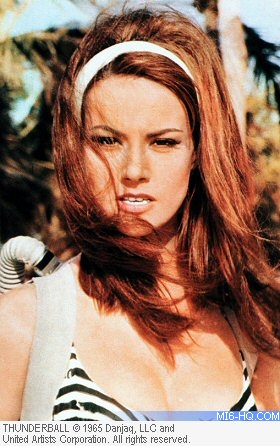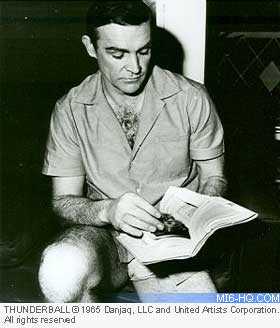 |
| |
MI6 trawls the archives to see how critics of
the day received Sean Connery's fourth outing as
007 at the height of Bond Fever in 1965 film "Thunderball"... |
|
Time Tunnel: Review Rewind
13th June 2010
New York Times - December 22nd,
1965
The popular image of James Bond as the man who has everything, already magnificently
developed in three progressively more compelling films, is now being cheerfully
expanded beyond any possible chance of doubt in this latest and most handsome
screen rendering of an Ian Fleming novel, "Thunderball."
Now Mr. Fleming's superhero,
still performed by Sean
Connery and guided through this
adventure by the director of his first two, Terence Young,
has not only power over women, miraculous physical reserves,
skill in perilous manoeuvres and knowledge of all things
great and small, but he also has a much better sense of
humour than he has shown in his previous films. And this
is the secret ingredient that makes "Thunderball" the
best of the lot.
This time old Double-Oh Seven, which is Mr. Bond's code
number in the British intelligence service he so faithfully
and tirelessly adorns, is tossing quips faster and better
then he did even in "From
Russia With Love," and
he is viewing his current adventure with more gaiety and
aplomb.
I think you will, too. In this creation of superman travesty,
which arrived yesterday at the reopened Paramount, the
Sutton, Cinema II and twoscore or more other theaters in
the metropolitan area. Bond is engaged in discovering who
hijacked two nuclear bombs in a NATO aircraft over Europe
and is secretly holding them for a ransom of £100
million.
|
|
 |
That in itself is fairly funny — fanciful
and absurd in the same way as are all the problems that require
the attention of Bond. But what Richard Maibaum and John Hopkins
as the script writers have done is sprinkle their gaudy fabrication
with the very best sight and verbal gags.
"Let my friend sit this
one out." Bond asks politely of two disinterested young
men as he places his dancing partner in a chair beside them at
a table in a nightclub in Nassau. The gentlemen nod permission. "She's
just dead," he explains.
Or when Bond leaps from a hovering helicopter wearing a skindiver's
suit of extraordinary mechanical complexity to engage in an underwater
war between SPECTRE and C.I.A. frogmen in the climactic scene
of the film, he flips the conclusive comment: "Here comes
the kitchen sink!"
 |
|
In addition to being funny, "Thunderball" is
pretty, too, and it is filled with such underwater action
as would delight Capt. Jacques-Yves Cousteau. The gimmick
is that the airplane carrying the hijacked bombs has been
ditched, sunk and covered with camouflaging on a coral
reef off Nassau. And to get this information and then find
and explore the sunken plane. Bond has to do a lot of skindiving,
with companions and alone.
The amount of underwater equipment the
scriptwriters and Mr. Young have provided their athletic
actors, including
an assortment of beautiful girls in the barest of bare
bikinis, is a measure of the splendour of the film. Diving
saucers, aqualungs, frogman outfits and a fantastic hydrofoil
yacht that belongs to the head man of SPECTRE are devices
of daring and fun.
So it is in this liveliest extension of the cultural scope
of the comic strip. Machinery of the most way-out nature
become the instruments and the master, too, of man. "I
must be six inches taller," Bond wryly quips at one
point after he has been almost shaken to pieces on an electric
vibrating machine. The comment is not without significance.
This is what machines do to men in these extravagant and
tongue-in-cheek Bond pictures. They make distortions of
them.
|
Mr. Connery is at his peak of coolness and nonchalance with
the girls. Adolfo Celi is piratical as the villain with a black
patch over his eye. Claudine Auger, a French beauty winner, is
a tasty skindiving dish and Luciana
Paluzzi is streamlined as
the inevitable and almost insuperable villainous girl.
The color is handsome. The scenery in the Bahamas is an irresistible
lure. Even the violence is funny. That's the best I can say
for a Bond film.
Variety - 1965
Sean Connery plays his indestructible James Bond for the
fourth time in the manner born, faced here with a $280 million
atomic bomb ransom plot. Action, dominating element of three predecessors,
gets rougher before even the credits flash on.
Richard
Maibaum (who coscripted
former entries) and John Hopkins' screenplay [based on
an original screenplay by Jack Whittingham, from the original
story by Kevin McClory, Whittingham and Ian Fleming] is
studded with inventive play and mechanical gimmicks. There's
visible evidence that the reported $5.5 million budget
was no mere publicity figure; it's posh all the way.
Underwater weapon-carrying
sea sleds provide an imaginative note, as does a one-man
jet pack used by Bond in the opening sequence, reminiscent
of the one-man moon vehicle utilized by Dick Tracy in
the cartoon strip.
Connery is up to his usual stylish self as he lives up
to past rep, in which mayhem is a casual affair.
Adolfo Celi brings dripping menace to part of the swarthy
heavy who is nearly as ingenious - but not quite - as the
British agent, whom, among other means, he tries to kill
with man-eating sharks.
Terence Young takes advantage of every situation in his
direction to maintain action at fever-pitch. |
|
 |
Time - December
24th, 1965
Thunderball spreads a treasury of wish-fulfilling fantasy
over a nickel's worth of plot. The fantasy is the familiar amalgam
of wholesale sex, comic-strip heroism, bogus glamour and James
Bond (Sean Connery). The plot concerns Bond's new nemesis, Largo.
As No. 2 man of Spectre, Largo masterminds a daring bombnap.
He hijacks a Vulcan bomber aloft on a NATO training flight, sinks
its atomic payload in the Atlantic near Nassau. Then, for an
asking price of £100 million, he promises not to obliterate
Miami or a city of equal size.
Though From Russia with Love remains the liveliest
Bond opera to date, Thunderball is by all odds the most spectacular.
Its script hasn't a morsel of genuine wit, but Bond fans, who
are preconditioned
to roll in the aisles when their hero merely asks a waiter
to bring some beluga caviar and Dom Pérignon '55,
will probably never notice. They are switched on by a legend
that plays straight to the senses, and its colors are primary.
Director
Terence Young dunks his camera into a swimming pool full
of sharks for the film's best single shot, a
fisheye view from below, filtered through a victim's blood.
In one donnybrook following a funeral, Bond slugs it out
with the widow—actually a male adversary—and
lifts himself up, up and away by backpack
jet. Still more
dazzling is a climactic, blue-green underwater battle between
Largo's men, wearing black rubber wet suits, and the brave
lads from Our Side, parachuting to the fray in flag red.
Bond's dry-land conquests were somewhat
zingier type in Goldfinger, but in Thunderball he manages
a change of pace by joining Largo's seaworthy French playmate
(Claudine Auger) for an amorous exploit down among the
corals. "I hope we didn't frighten the fish," he
quips afterward, wading ashore. Alas, even subaqueous sex
cannot keep the formula entirely fresh. |
|

|
Yet, if Thunderball's gimmickry
seems to overreach at times, Actor Connery gains assurance from
film to film, by now
delivers all his soppiest Jimcracks martini-dry. He is hilariously
astringent when he drops a limp dancing partner at a nightclubber's
ringside table, saying: "D'you mind if my friend sits this
one out? She's just dead." And indeed she is.
Related Articles
 James Bond Time Tunnel
James Bond Time Tunnel
 Thunderball
- Movie Coverage
Thunderball
- Movie Coverage